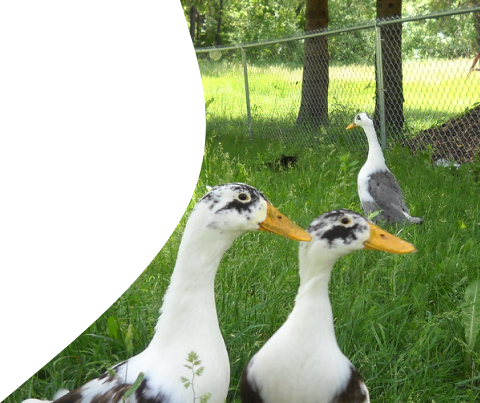
The Ancona duck is a unique and highly adaptable breed, cherished for its versatility in both egg production and meat yield. Originating in the United Kingdom in the early 20th century, these ducks are recognized by their distinct mottled plumage, with each bird having its own unique pattern. Ancona ducks are hardy and easy to care for, making them ideal for backyard enthusiasts and small farms. While they are relatively rare, their calm temperament and high productivity make them an excellent choice for those seeking a dual-purpose breed that excels in both performance and personality.
- Strong, upright stance
- White base with random black, chocolate, or blue patches
- Bright orange, adding vibrancy
- Medium to large, with a robust, well-proportioned build
- Flat, broad, and typically orange
- Large with a deep, strong chest, giving a sturdy look

BREED & ORIGIN
Ancona duck is believed to have originated in England, developed from the Indian Runner duck and other breeds. It was introduced to the United States in the early 20th century, where it became appreciated for its unique coloration and utility.

LIFE EXPECTANCY
In ideal conditions, Ancona ducks live for approximately 7-10 years. However, with proper care, protection from predators, and a healthy environment, some individuals can surpass this average lifespan.

HEIGHT & WEIGHT
Drakes (males): Typically weigh between 7 to 8 pounds (3.2 to 3.6 kg).
Ducks (females): Generally weigh between 6 to 7 pounds (2.7 to 3.2 kg).

Duckling: 6-8 weeks

Juvenile: 8 weeks to 4-5 months

Adult: 6 months
LOW
MEDIUM
HIGH
Temperament
Calm, friendly, excellent foragers
Activity Level
High, active foragers and enjoy
free-ranging
Climate Tolerance
Adapt well to both cold and
warm climates
Genetic Traits
Mottled plumage, high egg production, calm nature
Egg Laying Capacity
210-280 eggs per year
Broodiness
Moderate; not reliably broody, artificial incubation common

Feeding
Offer fresh water daily, and ideally, give access to a small pond or pool for bathing and hydration.

Housing
Provide secure, weather-protected shelter to keep them safe and comfortable, especially in extreme temperatures.

Health
Ancona ducks are low maintenance, needing clean water, secure shelter, and a balanced diet. They enjoy free-ranging and benefit from a small pond or kiddie pool.

Breeding Practices
Breeding Ancona ducks is a straightforward process, though the ducks are not particularly broody. Ancona hens can lay between 8-14 eggs per clutch, with an incubation period of about 28 days. Ducklings are precocial, meaning they are ready to swim and forage soon after hatching. While the breed's relatively low broodiness might require artificial incubation, hens that do sit on their eggs will make attentive mothers.
Nutritional Needs
Ducks require balanced nutrition, with higher protein levels during the early stages of growth. Ancona ducks need a balanced diet of duck pellets, grains, and fresh veggies. Free-ranging provides extra nutrients from insects and plants.
Flygrubs provide essential protein and calcium, supporting egg production. It complement their diet, providing high protein, healthy fats, calcium, and phosphorus and can be integrated into the diet from ducklings to adulthood. Easy to incorporate, can be fed
dried or rehydrated.

Ancona ducks are a rare, dual-purpose breed valued for heritage preservation and genetic diversity. Though less commercial than Pekins, their hardiness and high egg yield make them ideal for sustainable farms.
Category |
Details |
|---|---|
Breed |
Ancona Duck |
Origin |
United Kingdom |
Temperature |
Ideal range: 45-75°F (7-24°C) |
Common Health Issues |
Respiratory problems in poorly ventilated housing |
Commercial Use |
Eggs and meat production |
Backyard Use |
Great for small farms and family-friendly environments |
Breed Standards |
Not officially recognised by major poultry associations |
Exhibition |
Exhibited for unique plumage patterns and temperament |
Role in Culture |
Adapt well to both cold and warm climates |
Population Status |
Rare breed, but slowly increasing in numbers |
Conservation Efforts |
Heritage breed preservation |
Breeding Practices |
Selective breeding for egg production and meat yield |
Health and Maintenance |
Generally healthy with minimal issues |
Fertility Rates |
High fertility; artificial incubation may be needed |
Development |
Bred for dual-purpose: egg laying and meat |
Parasite Control |
Regular parasite management, ensure clean living conditions |
Market Value |
Ducklings: $7-$12 each |
Cost of Raising |
Approx. $40-$60 per duck per year (feed, housing, healthcare) |
- Prolific egg layers, laying between 210-280 eggs annually
- Calm and friendly demeanor, making them excellent for family farms
- Hardy in various climates and excellent foragers, reducing feed costs
- Dual-purpose breed, suitable for both eggs and meat production
- Relatively rare, so finding breeders may be difficult
- Not as broody as other breeds, so artificial incubation may be required
- Requires access to swimming water for optimal well-being

Ancona ducks typically cost between $7 and $12 per duckling, depending on the breeder and location. The price can increase due to their rarity, and adults or breeding pairs may cost significantly more. Additionally, if you are purchasing high-quality or show-standard ducks, expect prices to be on the higher end.